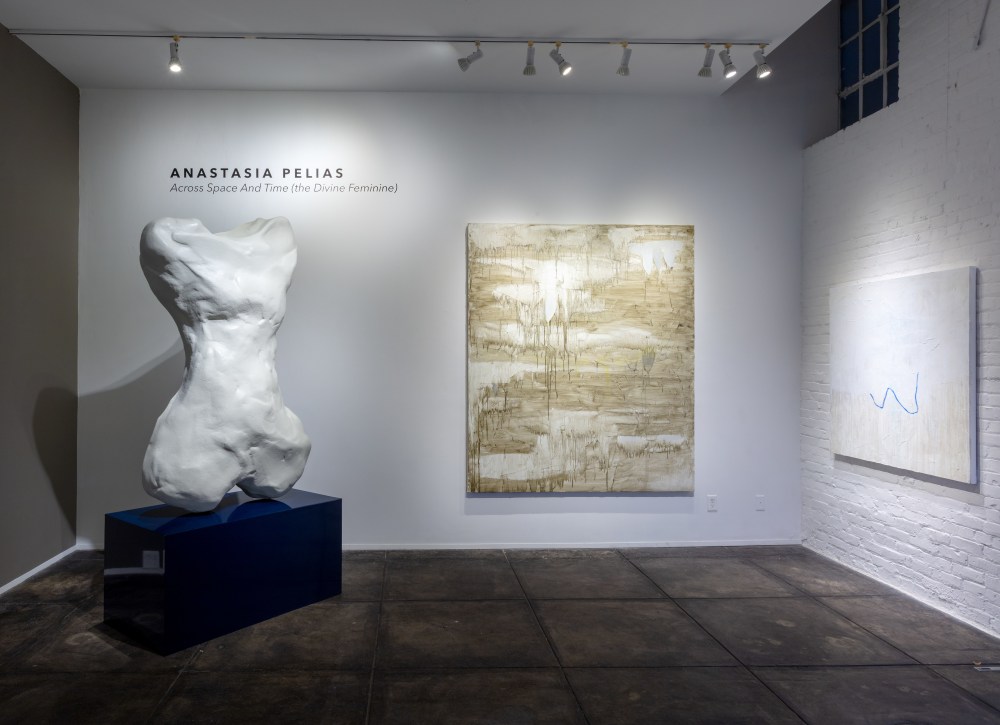
A passage in Rodin’s notebook describes a torso as “…that garden of pleasure the secret charms of which imbue old and young alike with a terrible power. Feminine charm which crushes our destiny, mysterious feminine power that retards the thinker, the worker, and the artist, while at the same time it inspires them—a compensation for those who play with fire!” Entering Anastasia Pelias’s Across Space and Time (The Divine Feminine) at JONATHAN FERRARA GALLERY, a six-foot torso-like form looms, echoing Rodin’s sentiment. This archetypal shape presides over the entryway, serving as the foundational marker upon which the exhibition operates. From the torso, all appendages extend.
In this current body of work containing ten paintings, seventeen works of charcoal and sumi ink on paper (displayed online, but not physically present in the gallery), and a single monumental sculpture, Pelias, a New Orleanian of Greek descent, explores the feminine through gestural abstraction. The paintings comprising the show are mostly muted fields of color punctuated by wiry marks of oil stick. A standout composition titled Aphrodite of Milos (I am she) recalls the ceiling of a cave—its surface layered with stalactite drippings. Near the midline, thin skeins of highlighter yellow trickle faintly across the canvas, hovering on the edge of visibility. A rounded triplet of icicle shapes reiterate the drips and resolve the upper right-hand corner with immediacy and painterly intelligence. Pelias’s decision making often delights in details, as a filled-in stalactite at the far left mimics the residue of a peeled-off sticker.
Certain titles overreach and exceed the scope of visual content, such as Dancing off the Cliff (for the Women of Souli), which references Souliot women who jumped to their death while dancing and singing in order to avoid capture by Ottoman forces. Pelias condenses the action into a brisk, emerald green arc. The degree of abstraction is so extreme that one could just as easily imagine the unfurling of hair, a polluted waterfall, a rainbow as a ribbon of pure velocity. A joyous abandon inhabits Pelias’s raw impressions—impulse superseding an overall effect. Expressive mark-making is showcased most clearly in Sleeping Beauty, Beauty Sleep—a collection of disparate lines on a shifting gray ground. These lines form a thread-bare composition, leading the eye in a loop without ever divulging any secrets. The exhibition itself proceeds in a similar manner, adopting a mélange of references, without ever unscrambling their significance.
One of the largest paintings in the show—Infinite Unapologetic Love—channels a cross section of Antarctic strata, an ineluctable emptiness cloaked in a sheen of ice. Thin stopgaps reveal where the layering process begins and ends. A downpour of cobalt blue, dark cerulean, smalt and denim run together and imply a frozen wilderness beyond the edges of the frame. Historically—taking into account both the title and the use of color—Philippe de Champaigne’s painting The Virgin of Sorrows comes to mind—the figure completely enveloped by a blue cloak at the foot of the Cross, likewise symbolizing an all-consuming love amid sorrow. But here, the blue is more general—a screen onto which any number of projections can be made. Unlike Aphrodite of Milos, the painting feels unembellished and basic, a simple expression where scale is the prime concern.
Emphasis is given to the sensitivity of the body, an instrument capable of transmitting powerful signals from dense fields of noise. Evidence of an underpainting is apparent in Smile, its traces almost obliterated by white paint. The piece is a perfect example of signal-to-noise ratio—where the cerulean waveform represents an unmistakable signal—and the background a wash of white noise. Fellow painters might be attuned to Smile’s modulated surface, but to the majority of viewers it’s easily ignored. What remains is an oscillating live-wire of electric blue—the artist asserting her presence as an embodied mind in action—torso as prism—refracting feminine power into abstraction.